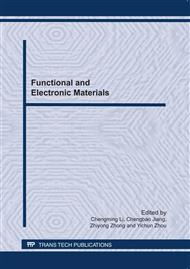p.694
p.699
p.706
p.711
p.716
p.722
p.729
p.734
p.739
Postdeposition Thermal Annealing Influence on the Activation of the Cosputtered AlN-ZnO Films
Abstract:
Cosputtered aluminum nitride-zinc oxide (AlN-ZnO) films at a theoretical atomic ratio of 10% [Al / (Al + Zn) at.%] were postannealed at 450°C for 30 min under ambient nitrogen and vacuum, respectively. The activated impurities in these annealed samples were investigated through the room-temperature (RT) and low-temperature (LT) photoluminescence (PL) spectra as well as their temperature-dependent Hall-effect measurements. It was found that the donor-acceptor-pair (DAP) emission related to VZn-AlZn transition at 2.86 eV predominated over the defect-transition luminescence in the RTPL spectrum of the vacuum-annealed sample, for which possessed a high electron carrier concentration. With the help of the temperature-dependent Hall measurement, the shallow donor level corresponded to Al on Zn site (AlZn) was derived as EC – (51±4) meV. By contrast, the RTPL spectrum of the nitrogen-annealed AlN-ZnO cosputtered film, showing p-type conduction with a hole concentration of 1018 cm-3, was dominated by the VO-NO deep level emission approximately at 1.87 eV. The estimated acceptor level corresponded to the N on O site (NO) was EV + (149±6) meV. The binding energy and activation energy associated with the NO acceptor were also determined by the LTPL and temperature-dependent PL spectra.
Info:
Periodical:
Pages:
716-721
Citation:
Online since:
June 2011
Authors:
Price:
Сopyright:
© 2011 Trans Tech Publications Ltd. All Rights Reserved
Share:
Citation:


